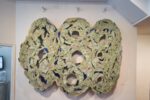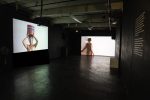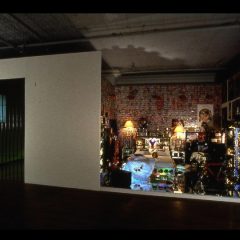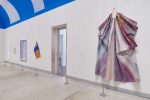Age was something that happened to Other People, so it was startling to walk into P.P.O.W. Gallery to see a huge, poster-sized photograph of Martha Wilson in her exhibition I have become my own worst fear (through Oct. 8, 2011). I hadn’t seen Wilson in twenty-five years and, turning to her dealer, Penny Pilkington (whom I’ve seen intermittently during the more than twenty years we’ve been aquainted, so we’ve aged slowly for each other) I said, I guess we’ve all gotten older.

The black and white photograph (taken by Michael Katchen) shows Wilson in harsh and unbecoming lighting; she wears no makeup, her hair is slicked back,and she looks all of her sixty-something years. On the adjacent wall is the 1974 video, Deformation, in which the much younger Wilson talks as she applies make-up to her face, hiding the bags under her eyes, instructing the photographer to shoot from above to disguise her double chin, and attempting to conform to a socially-constructed ideal of female beauty.
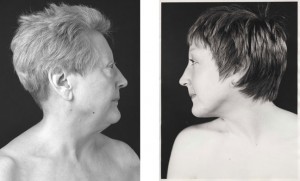
Age may be Wilson’s worst fear, although she’s not simply afraid of the invisibility it brings (made real in Invisible, below). Nor is she willing to disguise age’s imprint on the body. Before and After (1974/2008) are photographs of Wilson’s nude torso, both cropped at shoulder and crotch. The 1974 image is of an ideal, youthful woman with bountiful breasts and firm stomach; the photo from 2008 reveals the universal effects of time and gravity. Feminism and performance art both emphasized the inseparability of the body and self, and of self and art. Wilson may have feared aging in her youth, but in her maturity she’s still going strong.
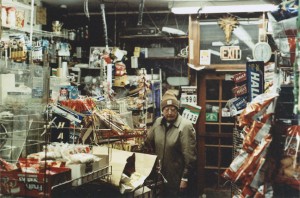
Wilson is as sassy and gutsy an older woman as she was a young one, and we are blessed by her revelations of herself and by extension, of us. I hope she’s found a lover whose vision has dimmed with age and who appreciates Ben Franklin’s advice to prefer old Women to young ones; Because as they have more Knowledge of the World and their Minds are better stor’d with Observations, their Conversation is more improving … And as in the dark all Cats are grey, the Pleasure of corporal Enjoyment with an old Woman is at least equal, and frequently superior, every Knack being by Practice capable of Improvement.
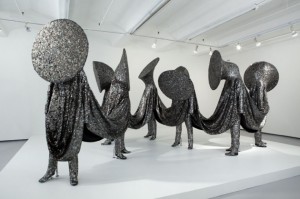
Nick Cave’s exhibition Ever-After at Jack Shainman Gallery (through Oct. 8) extends the artist’s carnivalesque Soundsuits in new directions. The seven, man-sized figures of Mating Season have rabbit ears and are entirely covered with soft, droopy fur like that of Afghan hounds (and undoubtedly look wonderful in motion). The gallery describes them as boyish bunny figures suggesting a sublime play of fornication, but they also suggest genetic modification gone awry.
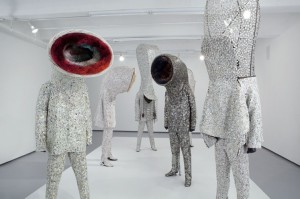
The Soundsuits in a back room have head coverings of futuristic designs (one resembles a bishop’s mitre, another a tuba’s horn, a third an abstracted fish), but the detail of hand-stitching visible on every one of the multitude of buttons with which they are encrusted emphasizes the very human handwork that produced them. Speak Louder (above) and a second installation have figures whose costumes are cojoined. If one interpretation of Cave’s Soundsuits is that clothes make the man, then these figures, tethered to each other by their social or aesthetic self-presentation, are tied by bonds stronger than mere taste or association; they are one.
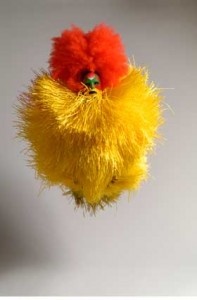
The gallery is screening a video of the artist’s performances, which makes it clear that many of the outfits are designed to be seen in motion. As multiple figures in puff-ball costumes run and jump, all indications of the wearers disappear as they became mobile, abstract forms.
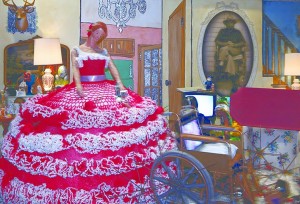
Pepon Osorio’s exhibition at Ronald Feldman Gallery (through Oct. 22, 2011) consists of one large installation in each of two rooms. Drowned in a Glass of Water revolves on a huge platform, each side revealing a tableaux of contrasting domestic scenes. Osorio has an ability similar to Edward Kienholz’s, of evoking human vulnerability through forms that suggest the human despite being only partially figural (or having figural attributes). The living-room of a modest home is cramped and chaotic. A large woman looms over the scene; she wears a red and white, crocheted ballgown and her arms are covered with bandages. In front of her is a wheelchair occupied by a figure, represented by a video screen which shows the hands of a woman crocheting the red and white yarn of the dress. Is the large figure a mannekin, or a dream of the incapacitated, knitting woman? Or are there two women in the room? A boy in a football helmet sits at the back, watching television; his back is to the room and to us, the viewers. Balloons with get-well wishes sit on a shelf, implying that someone is recuperating. The shelves are otherwise filled with a multitude of gimcrack figurines, the floor is littered with toys and a toppled, miniature Christmas tree.
The reverse of the platform is occupied by a sleeker and more monied scene: on a hospital litter lies a figure in the guise of a video screen again, whose imagery implies the interior of the body at a molecular level. Beside it a golden heart sits on the ground, covered in a glass bell jar of sorts, upon which rests a gold pocket watch. On the back wall in an elaborate, gold frame is a moving image of a waterfall. It’s impossible not to associate it with the flickering waterfall of Duchamp’s Étant donnés, but I can’t figure out what to make of that association. A mirror reflects an image of a woman’s mouth, eating from a silver spoon.
The work in the second room, Todo o nada (All or Nothing), is clearer in its references. To approach it we pass through security gates to find the bruised face of a boy looking out the window of a modest house, as we hear the voice of his mother who describes finding him beaten. Both works evoke the harshness of everyday life which, even for the wealthy, includes our common mortality. Osorio’s work is full of references to pain, yet the very efforts he puts into the representations implies some optimism, or at least hope of redemption. But the imagery of figures mired in difficulties pervades this exhibition.



